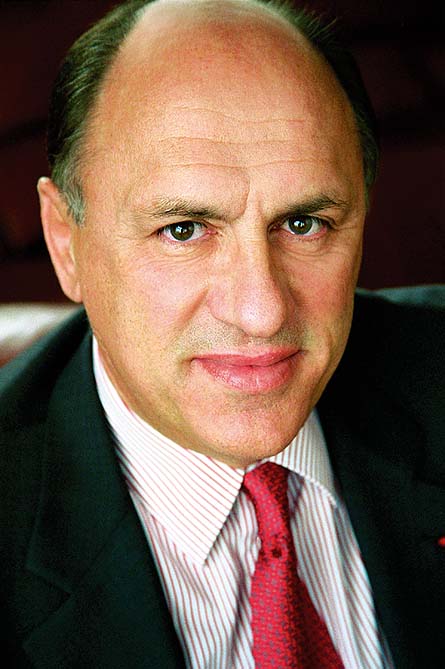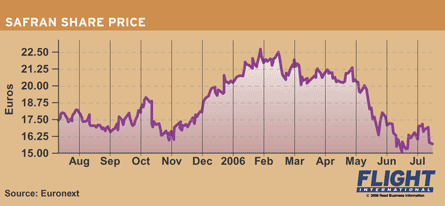By Murdo Morrison in Paris
It may make everything from mobile phones and bank cards to unmanned air vehicles, but its core propulsion business remains the engine of growth at Safran, the French aerospace and communications combine created just over a year ago by the merger of Snecma and Sagem.
 |
|---|
| Béchat: Two trains together |
The group last week reported a 10.8% rise in half-year revenues to €5.48 billion ($6.85 billion). The propulsion division - the former Snecma Moteurs - saw sales increase by more than 16% to €2.4 billion, thanks to surging demand for CFM56 engines for the Airbus A320 and Boeing 737 families - marketed by its CFM International joint venture with General Electric.
The aircraft equipment division - which includes former Snecma businesses Labinal, Messier-Dowty and Messier-Bugatti - also had a good start to the year, due to the buoyant market for airliners.
But with problems at the two former Sagem divisions - defence security and communications - Safran says it is likely margins will fall in 2006.
Revenues in the defence security business went up a fifth in the first half, but this was partly due to acquisition of German smart card specialist Orga, which Safran says had a "disappointing" half year. The communications business also continues to make heavy weather of a competitive global market for consumer products and Safran warns it will again lose money in 2006.
Speaking to Flight International in Paris, shortly before publication of these figures, chairman and chief executive Jean-Paul Béchat returned to a familiar theme: analyst scepticism of the merger, announced in late 2004, of two seemingly disparate businesses - state-owned Snecma, known for its heavy-duty aerospace hardware, and privately run Sagem, with its portfolio of consumer goods and specialist security technology.
Those who believed the logic behind the merger was instant cost savings or a range of jointly developed technologies were wrong, he says. "We heard all the comments from the beginning that there are no synergies between aircraft engines and mobile phones. I agree. But we have put two trains together, and there are places where the carriages are linked."
Already engineers from former Sagem and Snecma businesses are sharing expertise and technologies to develop products such as health monitoring systems for engines and electrical brakes for the Boeing 787, he says.
While the worldwide fleet of A320s and 737s ensures Safran a global market footprint, the company is bolstering its industrial presence in Russia and the USA. In the former, it is a key partner in the Russian Regional Jet (now Superjet100), supplying nacelles, thrust reversers and landing gear. Teamed with NPO Saturn, its PowerJet joint venture will make the SaM146 engine, now undergoing bench testing in Russia. In the USA, the contract win earlier this month by EADS North America to supply 322 UH-145 helicopters to the US Army will see Safran's Turbomeca helicopter engine unit extend its plant in Grand Prairie, Texas to assemble the 644 engines.
Snecma has been long established in the European defence market, its engines powering Dassault and Eurocopter aircraft, but Sagem has added another dimension in areas such as unmannned air vehicles, where Safran offers one of the few off-the-shelf European tactical UAVs, the Sperwer, operated by five nations including Canadian forces in Afghanistan. He hopes this experience in the market may lead to a role in developing a bigger, European-funded UAV, possibly able to deploy weapons. "Our hope is that the fact we are in there already with a product will be recognised, and that there will be a consolidation of programmes," he says. "We are not in the same boxing category as a Global Hawk, but we are low cost and we can deliver data, and we are doing it without government funding."

But it is the narrowbody engine market that will keep CFM56 assembly lines busy and investors happy for some time. Orders this year for the powerplant - the sole engine on the 737 and with three-quarters of the A320 family backlog - had reached more than 1,250 by 30 June and seem certain to smash last year's record of 1,640. With deliveries of 400 engines in the first half, and other Safran businesses key suppliers to Airbus and Boeing, one of the biggest challenges is going to be ramping up output to meet demand. This is something Béchat acknowledges. "Our big challenge today is not delays to the A380," he says. "It is to cope with the production rate and get the forgings from our suppliers."
Source: Flight International



















